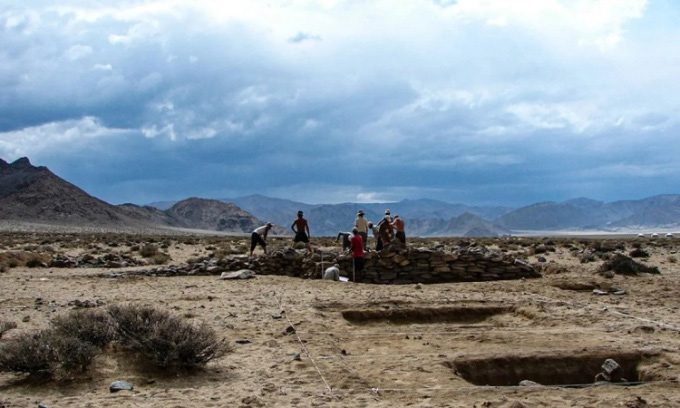Based on DNA analysis, researchers have uncovered many social characteristics of the Xiongnu Empire, which repeatedly invaded the territory of ancient China.

Archaeologists excavate the tomb of a noblewoman at a cemetery in Takhiltyn Khotgor. (Photo: J. Bayarsaikhan).
A nomadic empire that dominated the Asian steppes for three centuries from 200 BC, the Xiongnu engaged in trade along the Silk Road, built magnificent tombs, and conquered distant lands on horseback. The conflicts between this empire and China led to the construction of the Great Wall of China, which still stands today. By utilizing ancient DNA evidence combined with archaeological excavations, researchers have unveiled the secrets of one of the most powerful forces of that era. Their findings were published on April 14 in the journal Science Advances.
An international team of scientists completed genetic analyses at two cemeteries along the western border of the Xiongnu Empire, present-day Mongolia: a noble cemetery in Takhiltyn Khotgor and a local cemetery in Shombuuzyn Belchir. The scientists sequenced the genomes of 17 individuals from both cemeteries and discovered high genetic diversity, demonstrating that the Xiongnu Empire was racially, culturally, and linguistically diverse.
The genetic diversity in the population reveals that the Xiongnu Empire was not merely a collection of various groups united for a common purpose, according to Choongwon Jeong, an associate professor of biological sciences at Seoul National University. Among the individual graves, the highest status individuals were women, who held a particularly powerful role in Xiongnu society. Elaborately decorated coffins featuring gold representations of the Sun and Moon symbolized the strength of the Xiongnu. One grave even contained the remains of six horses and a chariot.
Women possessing materials not only showcased their status (such as belts and necklaces) but also demonstrated power, noted Bryan Miller, an associate professor of art and archaeology of Central Asia at the University of Michigan. They were honored with numerous offerings from attendees at funerals, indicating their importance within the community.
The study also revealed information about the lives of Xiongnu children. Similar to adult men, young boys were buried with bows and arrows, unless they were under the age of 11. Children were buried differently based on their age and gender, providing insights into Xiongnu society.
Ursula Brosseder, a prehistorian at the University of Bonn, emphasized that this research offers deeper insights into the social characteristics of the Xiongnu Empire, using genetics as a tool. The strength of the Xiongnu Empire inspired many later nomadic tribes originating from the Eurasian steppes, such as the Mongol Empire.


















































